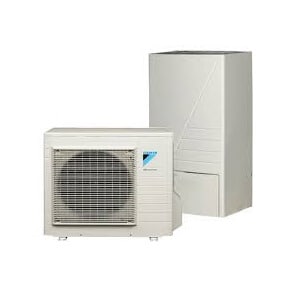
How Do They Work?
They extract heat from the outside air in the same way that a fridge extracts it from inside. Heat from the air is absorbed into the unit as a fluid. This is then pumped through a heat exchanger within the pump.
Low grade heat is then extracted by the refrigeration system and passed through the compressor. It is then concentrated into a higher temperature to make useful heat.
The heat generated is capable of heating water sufficiently to fulfill the requirements of the heating and hot water circuits of a house.
Product Videos
Air Source Heat Pump Installation Benefits
- Lower fuel bills, especially if you are replacing conventional electric heating, oil or LPG heating
- Potential income through the UK government’s Renewable Heat Incentive (RHI)
- The potential for lower home carbon emissions, depending on which fuel you are replacing
- No fuel deliveries needed
- You can heat your home as well as your water
- Minimal maintenance required
- Installation generally easier than a ground source heat pump
Key Selection Questions
When assessing the suitability of an air source heat pump installation you will need to answer the following questions;
Where will the pump be sited outside of the property?
For planning permission under permitted development rules it must be at least 1 metre from the property boundary.
Where will the hot water cylinder and / or hydrobox be located inside the property?
The space requirements for the equipment should be checked to ensure there is sufficient room.
Which type of emitter system will be used – radiators or underfloor heating?
If the new emitters are to be supplied then they can be sized to suit. They are selected to provide both maximum efficiency and the lowest running costs. If existing, then the correct heat pump needs to be selected to deliver the correct level of heating performance.
What form of control of the heating and hot water would be required?
It is possible to set up heating zones to different parts of a property. These can be based on both time and temperature control. Management can be either centrally or remotely by smartphone.
Product Options
- ASHP must be sited within 10m of the hot water cylinder
- Can be directly connect to hot water cylinder
- Can be sited up to 35m from the hot water cylinder
- Uses refrigerant to minimise heat loss between pump and cylinder
- Requires installation of hydrobox for heat transfer prior to cylinder connection



Key Features
- Cooling function available
- High Temperature unit can produce hot water up to 70C
- Cascade function possible for higher loads
- Single and Three phase options
- Online monitoring available
- A lifespan of 25 years MCS approved installers
Key System Components



